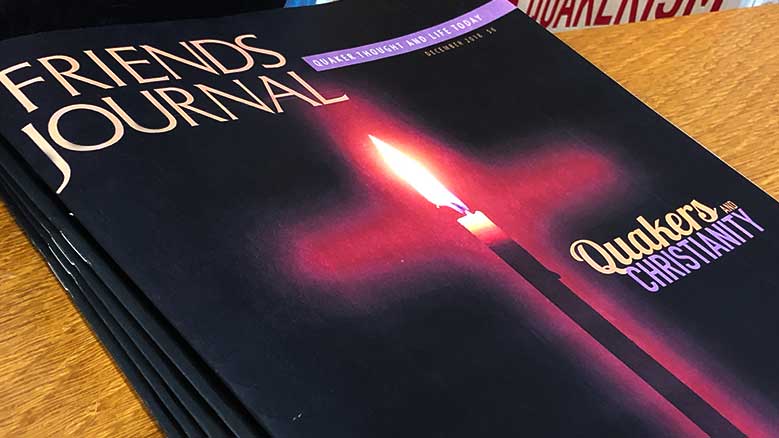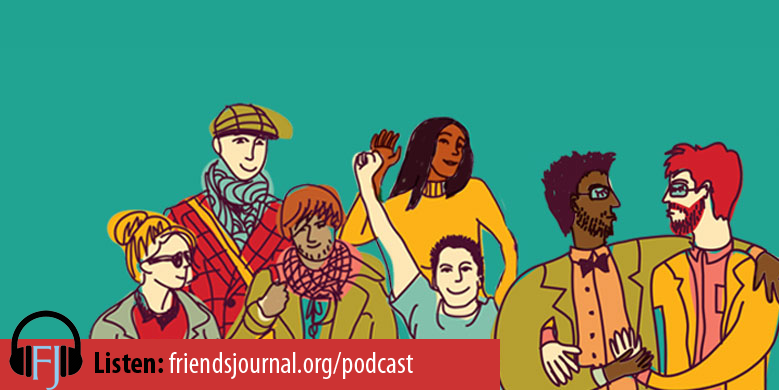I think that I am something of an oddity among the readers of Friends Journal. I grew up in a pastoral meeting and still belong to one. I don’t see myself as much of an activist, largely out of a sense that a lot of Quaker activism is counterproductive. Not infrequently I find myself smiling at letters or articles that I am sure the authors did not intend as humorous. Yet I have been a subscriber for over 20 years, and when renewal time comes, I always resubscribe for the longest possible time (and not just out of ingrained Quaker frugality).
My affection and esteem for Friends Journal grow out of two sources. One is deeply personal and spiritual. By divine leading—or some genetic contrariness, or perhaps sheer perversity—I have always been skeptical of received orthodoxies. It was a happy thing that I was born into a faith whose identity has in large part been founded on suspicion of creeds and skepticism about demands that happiness or salvation depend on thinking in a certain way. Thus Friends Journal is the logical end of that insistence on intellectual and spiritual independence. While I am sure that there are certain orthodoxies that the editors do enforce, they are enough like the ones that I have reached on my own that they usually do not chafe. And in the wide range of views, even those not always expressed in the most Friendly of ways—even those that I find incredible or irrational or downright silly—I find comforting evidence that Friends are still seeking and finding truth.
The other source is, one might say, professional. I am an historian by training and vocation, an historian of Quakerism. For historians of religion over the past two centuries, religious periodicals are perhaps the most primary of sources. Here we find official positions in editorials, debates that question those official positions, news from congregations, obituaries that are often the most detailed biographical information that we possess for a given individual, and, most of all, masses of writing that reflect the spiritual outlook of at least a literate and articulate group within the denomination. The question the historian always confronts, however, is: how representative is this? Do the editors and clerics who created or collected most of the material really reflect congregational life or the experiences of individual members? While some Friends will disagree, my sense is that Friends Journal is a good reflection of the lives of most Friends in unprogrammed meetings in North America in the past half-century.
That historical vocation has led me to read virtually every issue of Friends Journal since the first one in 1955, and to save every one that I have received since my subscription began in May 1984. To describe and analyze every aspect of Friends Journal over 50 years would be far beyond an article of this length. But I have come away with certain impressions that I think are worth noting.
Friends Journal reflects a Quakerism that has changed in significant ways since the 1950s. Its existence is, of course, a reflection of one of the great achievements of 20th-century Friends, the reunion of the two Philadelphia Yearly Meetings in 1955. To unite The Friend, which Orthodox Friends had established in 1827 to expose and combat the pernicious errors of "Hicksism," and the Friends’ Intelligencer, which Hicksite Friends had been publishing since 1844, was a manifestation of the healing of wounds that went back over a century. The Friend, moreover, had not been merely Orthodox. From the 1840s into the early years of the 20th century it had been stalwartly Wilburite, critical of any innovation that suggested yielding either to pastoral Friends or Hicksites. Doubtless its union with a Hicksite publication caused a rumbling in at least a few graves in Orthodox burying grounds in New England, the Delaware Valley, and Ohio. Friends Journal has continued to report on the lives and activities of the three Conservative yearly meetings of Iowa, North Carolina, and Ohio, particularly the first two as most of their members have moved closer to Friends General Conference. But its focus has been on Friends in the Hicksite tradition, as now found in FGC and independent yearly meetings.
As publishing has changed, so has the Journal. Photographs, which were rare in 1955, have now become a staple. Environmental concerns about paper that can be recycled, which existed in the minds of a handful of Friends in 1955, now are paramount. And it appears that Friends are more likely to write letters to the editor today than 50 years ago. At least the editors think it worthwhile to give them more space. Friends’ Intelligencer and The Friend had been weeklies. That continued until 1960, when Friends Journal became a biweekly, a publication schedule that held until 1987, when it became a monthly.
Reading Friends Journal also suggests changes in who unprogrammed Friends are. In early years, the obituary columns continued to regularly feature surnames that would have been familiar to any Friend 200 years earlier: members of old Quaker families that had been active in Philadelphia, New York, and Baltimore Yearly Meetings, in some cases since the 17th century. Those names still appear, but with less frequency. Today I am struck by how obituaries usually include as a matter of course some mention of previous religious affiliations and how the subject became a Friend.
Friends Journal also reflects a North American Quakerism that has become thinner, increasingly dispersed. While I have not done a systematic quantitative analysis, my impression is that in its early years, most of the writers of articles and letters, most of the news items from meetings, came from somewhere between Lincoln, Virginia, and Portland, Maine. Contributions from overseas usually came from London Yearly Meeting. There was still an implicit assumption that most readers would know each other, through attendance at Friends General Conference sessions, through American Friends Service Committee, through travel to yearly meetings, through attendance at George School or Swarthmore, or through family ties. By the 1970s, however, the Journal had become both more national and international. Contributions come from all over the United States and Canada, and increasingly from all parts of the world.
As one would expect in a periodical that tries to reflect and serve a religious movement, articles, letters, and reports that reflect questions of belief and theological and doctrinal debates are always prominent. In 1955, it is clear that most of the contributors to the new Friends Journal saw themselves as religious liberals, as most Hicksite Friends had for at least three generations. The boundaries of that liberalism steadily expanded in the last half-century. In the 1950s, Friends, even when seeing themselves on the theological left, perceived themselves as liberal Christians. Today, a flourishing and articulate Quaker universalism denies that Quakerism is necessarily Christian, and argues that to define it in such terms is unnecessarily narrow and exclusive.
While, as I will note below, some forms of activism, especially on peace and race, have been central to Friends Journal since 1955, other new ones have appeared. Feminism was apparently not an issue for Friends, at least not one that they wrote about, in the 1950s. Friends Journal followed trends in the larger U.S. society in beginning to give it attention in the late 1960s. It has been a perennial subject since. Similar is coverage of ecology and environmental issues. While writing about nature was frequent in the 1950s, "pollution" was a word that did not appear until the 1960s. By 1970, however, it was a rare issue that did not address some environmental concern in some way.
Perhaps the most striking change has been in attitudes toward human sexuality. Reading Friends Journal in the 1950s gives no indication that any Friends were publicly challenging the moral norms and standards of the larger society. Same-sex relationships or sexual relations outside of wedlock were simply not a topic of discussion; the birth of a child to an unmarried woman was certainly not something to be publicized or celebrated. Debates over heterosexual relationships began in the 1960s, and by the 1970s gay liberation had become a topic of discussion.
While change is striking, so is continuity. Since the 1950s, the urge to carry out Quaker testimonies for the betterment of human society has never been absent from the pages of Friends Journal. Beginning publication a year after the Supreme Court’s Brown vs. Board of Education decision, and in the same year that the Montgomery bus boycott made Martin Luther King Jr. an international figure, Friends Journal has given continuing attention to questions of race in U.S. society. From the beginning it backed the Civil Rights movement, reporting on developments in the South, particularly the work of Friends or Quaker organizations like AFSC. By the late 1960s, more radical, less patient voices were heard. Friends debated whether the tiny proportion of Quakers who were African American reflected the racism of the larger U.S. society. Friends did not all respond alike when black activists staged a sit-in during Philadelphia Yearly Meeting sessions to demand reparations for slavery and oppression. As affirmative action became an issue in the 1970s, most contributors decried what they saw as an attempt to preserve white privilege, although a few argued for the desirability of what they called a color-blind society. For the last decade, numerous contributors have bemoaned the racial homogeneity of unprogrammed Quakerism while blasting what they see as a resurgent racism in the larger U.S. culture.
Friends Journal has also reflected the strain within U.S. Quakerism that has been most articulately and uncompromisingly devoted to the Peace Testimony. That has meant not simply abstaining from violence, even in self-defense or to advance some good cause, but, as many statements put it, working actively "to remove the occasions for war." The launch of the new Journal coincided with the publication of the landmark AFSC statement Speak Truth to Power, which at the height of the Cold War argued that unilateral disarmament was preferable to the limitations on freedom that the national security state entailed. In the 1960s, the Vietnam War became the subject of more stories than any other topic. A focus on other conflicts, in Central America, the Caribbean, and the Persian Gulf, followed. The common theme in nearly all of the letters and articles treating them was not just the immorality and evil of warfare, but the aggressiveness and wrong-headedness of the U.S. government in responding to perceived challenges. A similar course can be seen in responses to the Israeli-Palestinian conflict. Until the late 1960s, it received relatively little attention. For the last 35 years, however, it has been a perennial subject marked by more conflict than most. The majority of stories and letters have been sympathetic to Palestinians and critical of Israeli policy, but not all. At times, exchanges have involved ferocious rhetoric that brandished words like "anti-Semitic" and "genocide."
To be sure, Friends Journal has seen some low points. Doubtless there have been articles or letters that their authors later wished had never seen the light of day, such as those that saw Fidel Castro or the North Vietnamese as misunderstood crusaders for freedom. Predictions about the future have been especially tricky, as past forecasts about the disappearance of capitalism or organized religion bear witness. A few editorials, with the benefit of hindsight, now strike this Friend as, at best, misguided, and at worst, just wrong. At times, Friends have simply been un-Friendly toward each other, with rhetoric that seemed more appropriate to a political attack advertisement or talk radio than religious discourse.
These failings are, however, simply reflections of the humanity in the small part of the human family that calls itself Friends. Friends Journal for 50 years has reflected all of the loves, hates, passions, enthusiasms, fixations, idealism, and aspirations of the family of Friends. And, in all, I have found it a good story to contemplate.




